The AMD Trinity Review (A10-4600M): A New Hope
by Jarred Walton on May 15, 2012 12:00 AM ESTAMD Trinity General Performance
Starting as usual with our general performance assessment, we’ve got several Futuremark benchmarks along with Cinebench and x264 HD encoding. The latter two focus specifically on stressing the CPU while PCMarks will cover most areas of system performance (including a large emphasis on storage) and 3DMarks will give us a hint at graphics performance. First up, PCMark 7 and Vantage:
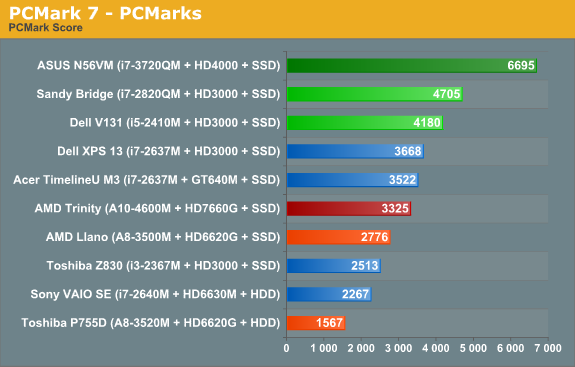
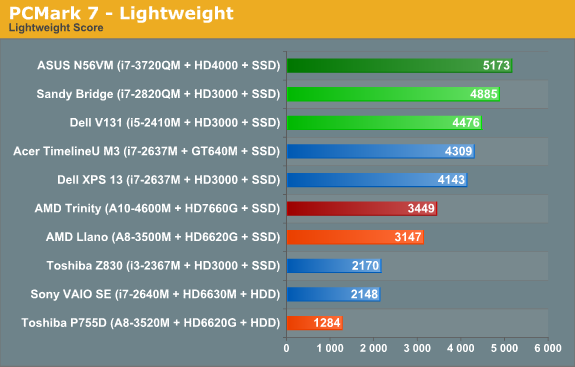
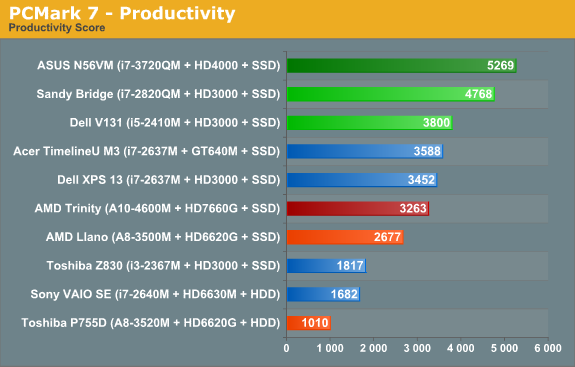

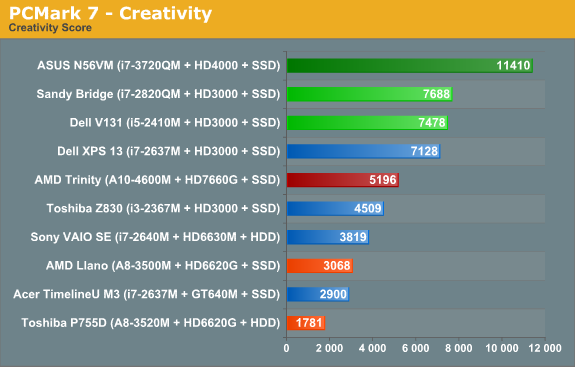
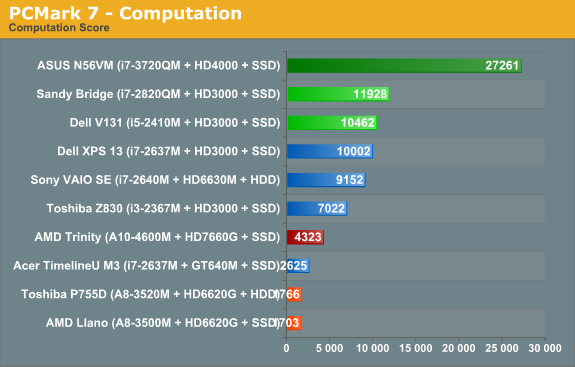
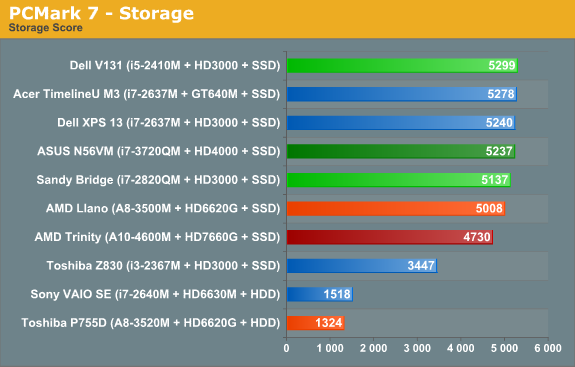
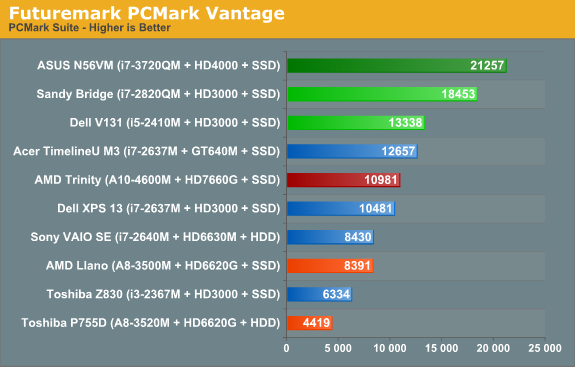
As noted earlier, we ran several other laptops through PCMark 7 and PCMark Vantage testing using the same Intel 520 240GB SSD, plus all the ultrabooks come with SSDs. That removes the SSD as a factor from most of the PCMark comparisons, leaving the rest of the platform to sink or swim on its own. And just how does AMD Trinity do here? Honestly, it’s not too bad, despite positioning within the charts.
Obviously, Intel’s quad-core Ivy Bridge is a beast when it comes to performance, but it’s a 45W beast that costs over $300 just for the CPU. We’ll have to wait for dual-core Ivy Bridge to see exactly how Intel’s latest stacks up against AMD, but if you remember the Llano vs. Sandy Bridge comparisons it looks like we’re in for more of the same. Intel continues to offer superior CPU performance, and even their Sandy Bridge ULV processors can often surpass Llano and Trinity. In the overall PCMark 7 metric, Trinity ends up being 20% faster than a Llano A8-3500M laptop, while Intel’s midrange i5-2410M posts a similar 25% lead on Trinity. Outside of the SSD, we’d expect Trinity and the Vostro V131 to both sell for around $600 as equipped.
A 25% lead for Intel is pretty big, but what you don’t necessarily get from the charts is that for many users, it just doesn’t matter. I know plenty of people using older Core 2 Duo (and even a few Core Duo!) laptops, and for general office tasks and Internet surfing they’re fine. Llano was already faster in general use than Core 2 Duo and Athlon X2 class hardware, and it delivered great battery life. Trinity boosts performance and [spoiler alert!] battery life, so it’s a net win. If you’re looking for a mobile workstation or something to do some hardcore gaming, Trinity won’t cut it—you’d want a quad-core Intel CPU for the former, and something with a discrete GPU for the latter—but for everything else, we’re in the very broad category known as “good enough”.


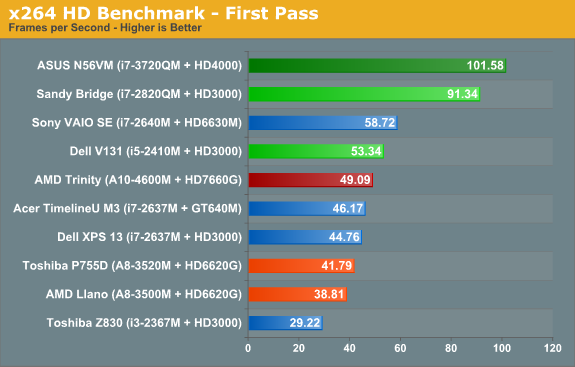
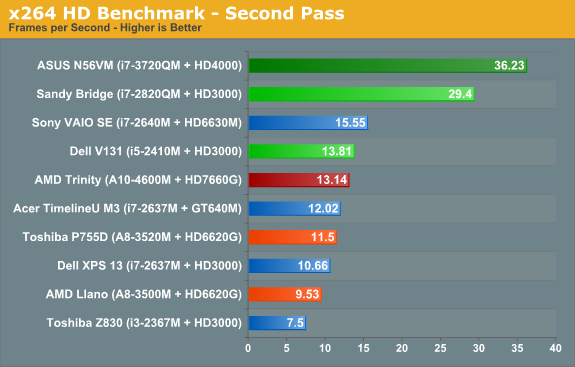
When we start drilling down into other performance metrics, AMD’s CPU performance deficiency becomes pretty obvious. The Cinebench single-threaded score is up 15% from 35W Llano, but in a bit of a surprise the multi-threaded score is basically a wash. Turn to the x264 HD encoding test however and Trinity once again shows a decent 15% improvement over Llano. Against Sandy Bridge and Ivy Bridge, though? AMD’s Trinity doesn’t stand a chance: i5-2410M is 50% faster in single-threaded Cinebench, 27% faster in multi-threaded, and 5-10% faster in x264. It’s a good thing 99.99% of laptop users never actually run applications like Cinebench for “real work”, but if you want to do video encoding a 10% increase can be very noticeable.

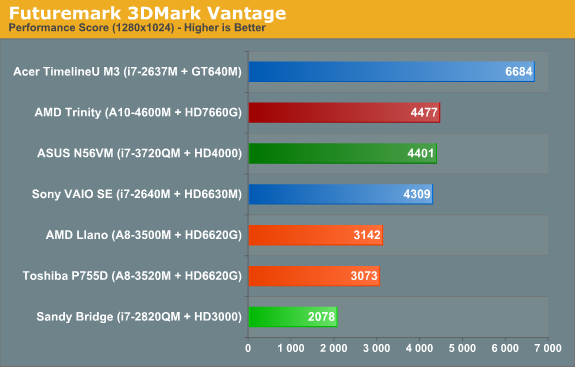
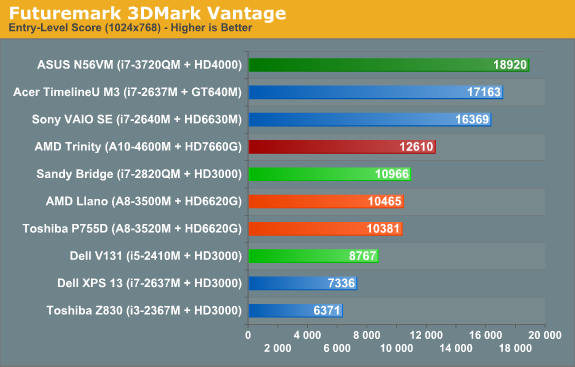
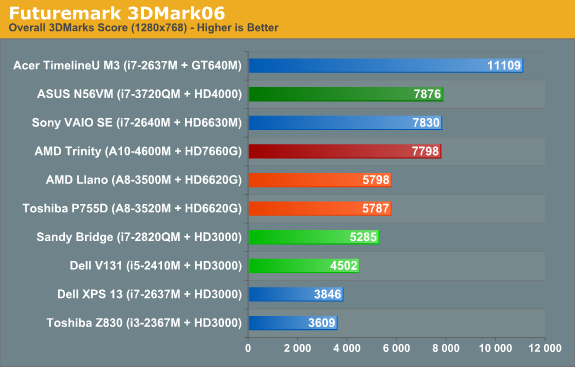
Shift over to graphics oriented benchmarks and the tables turn once again...sort of. Sandy Bridge can’t run 3DMark11, since it only has a DX10 class GPU, but in Vantage Performance and 3DMark06 Trinity is more than twice as fast as HD 3000. Of course, Ivy Bridge’s HD 4000 is the new Intel IGP Sheriff around these parts, and interestingly we see Trinity and i7-3720QM basically tied in these two synthetics. (We’ll just ignore 3DMark Vantage’s Entry benchmark, as it’s so light on graphics quality that we’ve found it doesn’t really stress most GPUs much—even low-end GPUs like HD 3000 score quite well.) We’ll dig into graphics performance more with our gaming benchmarks next.










271 Comments
View All Comments
deathpony - Tuesday, May 15, 2012 - link
Also the Gpu overclock wasn't limited by the chip itself but by a bios limitation, by staying at stock voltage i could have reached 2.5 Ghz realistically. But with such high clocks i think the Gpu was starved by the main memory bandwidth.Rookierookie - Tuesday, May 15, 2012 - link
Let's not forget though, A New Hope came BEFORE The Empire Strikes Back...JarredWalton - Tuesday, May 15, 2012 - link
But it also came after the Phantom Menace, Attack of the Clones, and Revenge of the Sith. *Shudder* Thanks for making me remember baby Anakin and Jar Jar, you cruel, cruel person.... ;-)wintermute000 - Tuesday, May 15, 2012 - link
looks like a nice well rounded product for the budget to mid range.the CPU is fine for 'normal' workloads, and the IGP can handle AAA titles @ medium detail 720p.
Agreed the devil is in the pricing, it needs to be substantially cheaper than i5+optimus otherwise theres no point.
phatboye - Tuesday, May 15, 2012 - link
When referring to AMD Bulldozer based architectures please use the term "module" instead of "core" as it gets confusing as to which one you are talking about.JarredWalton - Tuesday, May 15, 2012 - link
If you know enough to post this comment, you should also know enough to understand from context whether we're talking about a Piledriver core (e.g. the INT core) or a Piledriver module (e.g. two INT cores and the shared FP). And trust me, it's just as confusing trying to write about Bulldozer architectures as it is to read about them. But if there's a specific place in the article where we say "core" when we should say "module", let me know where and I'll be happy to correct it.phatboye - Tuesday, May 15, 2012 - link
Actually I was confused at first. On the first page you stated that the A10 chip was a 4 core chip. Before reading this article I was under the impression that the first trinity chips would have 8 cores (4 modules). It took a bit of reading before I realized that what you said was actually correct in that in that it is a 4 core (2 module) CPU.Yes the misunderstanding was totally my fault but it would make things a lot easier if you made a convention when referring to AMD bulldozer "cores" in terms of modules instead.
Cow86 - Tuesday, May 15, 2012 - link
You seem to have forgotten to mention the 'resonant clock mesh' technology that AMD recently acquired, and uses in Piledriver (and therefore Trinity)...said to account for a ~10% saving in power consumption at the same clockspeed alone already.Anyway, I'm rather pleased to see this part arrive :) Seems to put AMD in a much better position in the mobile space again, and I'd be very interested to see how they can compete with ultrabooks this time around with their 17W chips. Now to wait how they measure up on the desktop as well...And of course the new FX CPU's later this year...bodes well for those too, looking at the reduced power consumption, as their high power draw is the biggest problem right now.
mikato - Wednesday, May 16, 2012 - link
Yeah nice catch. I forgot that was going in Trinity.ltcommanderdata - Tuesday, May 15, 2012 - link
In one of the AMD slides on the first page, it mentions Trinity supports AVX1.1. I haven't heard of that standard before, only AVX and AVX2. What does AVX1.1 add over AVX and is AMD the only one to implement it right now?I also saw you tried WinZip 16.5 OpenCL and Ivy Bridge OpenCL which I commented on before. Thanks for that. Too bad the results didn't turn out that exciting.